Thanet Sewer Rehabilitation Scheme – Phase 2 (2019)
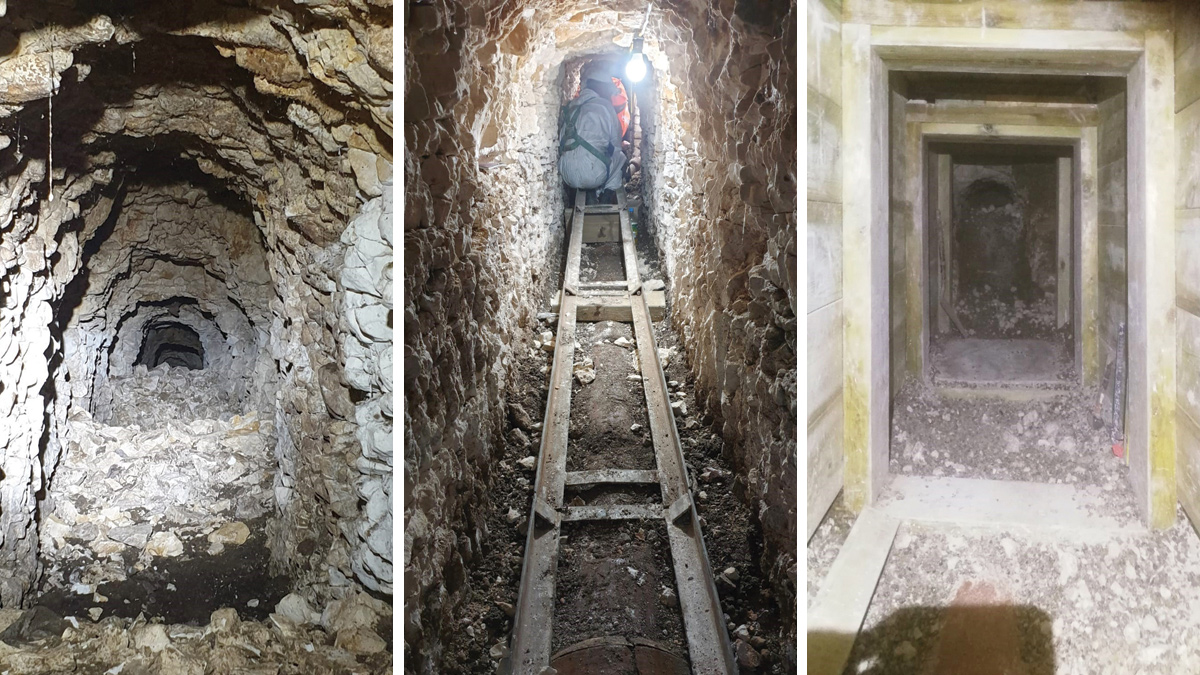
(left) Thanet’s sewer network was built within tunnels, hand-dug through the chalk more than a century ago (middle) The tunnels are cleared of debris and repaired, and the sewer pipes that run along the bottom of the tunnels are also checked and rehabilitated and (right) Timber headings are used where required to make the tunnels safe and prevent future collapses - Courtesy of TPMD
Southern Water has started the second phase of its major upgrade of the 100-year-old sewer network across Thanet, Kent. Representing an investment of circa £100m over AMPs 5, 6 and 7, the upgrade aims to maintain the integrity of the sewers, reduce the risk of flooding and protect the environment and chalk aquifer that spans much of the area. The network was constructed more than a century ago by miners who excavated underground tunnels through chalk and built the pipelines within them. These tunnels remain in place, more than 10m deep in some places and continue to act as a conduit for the sewer network. The depth and complex pipeline configuration presents some unusual challenges, not least how the sewers are accessed to complete the work. To overcome these problems, underground confined spaces specialists, trenchless technology and bespoke systems are being used. This article is about the work taking place across Ramsgate and Broadstairs that started in August 2018.
The challenge
In partnership with the Environment Agency (EA), as part of its wider Water Quality Programme, Southern Water are upgrading more than 10km of the existing Thanet sewer network to prevent exfiltration.
The network is complex and unique within the UK – large sections of the network are housed in chalk tunnels, which were mined in Victorian times to maintain a full gravity network. Added to this complexity is the presence of a key aquifer below. Covering 440km, not all of Thanet’s sewer network is housed within chalk tunnels. Therefore, part of the challenge was to identify sections of the network that are.
The prevention of exfiltration is to be achieved by upgrading, rehabilitating, cured-in-place pipe (CIPP) lining and sealing sections of the existing network, using innovative and trenchless techniques.
Design development
Adit identification: At the start of the project the crucial first step was identifying the adit locations and understanding the condition. For AMP6 the sewer length within the towns of Ramsgate and Broadstairs is 164km, far longer than the network area addressed in AMP5. Southern Water’s in-house design team Engineering Technical Solutions (ETS) took responsibility for scoping the survey works and the outline design. A review of existing data was undertaken to refine the length of CCTV surveys required. Asset data was also used to eliminate a number of pipes based on age and function. However an extensive programme of 121km of CCTV surveys and 2,400 conventional manhole surveys was still required to pinpoint manholes with adits.
On advice from Southern Water’s R&M contractor, Cappagh Brown, 184 of the manholes were vertically scanned in 3D using an innovative 360° panoramic camera; this saved 92 hours of confined space entries. The output formats included point cloud data and ‘unwrapped images’, which allowed adit dimensions and condition to be assessed.
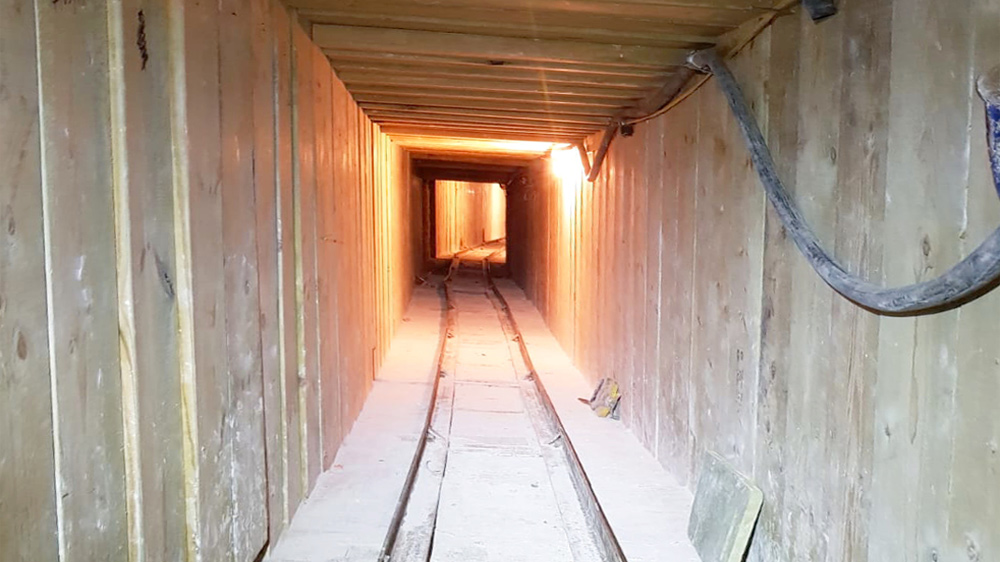
Some tunnels required extensive timber headings due to very poor condition – Courtesy of TPMD
Outline design: Due to project value, the contract was open-tendered via the OJEU process. The regulatory date for the scheme meant that the survey, design and procurement phases had to be overlapped. Thus several design iterations were necessary to support the procurement process, with design certainty increasing with time.
A key design philosophy throughout was to maximise in-adit storage by installing CIPP liners inside the adits wherever possible to minimise working at street level. However the surveys identified a number of small adits that appeared unsuited to lining. Therefore value engineering sessions held with the delivery partners were vital in rationalising the assumptions made in the design around manhole detailing and adit lining dimensions. The exercise reduced the number of offline pumped-return storage tanks, with their associated maintenance implications. It was however clear that the adit surveys in the delivery stage would be vital to finalising the design.
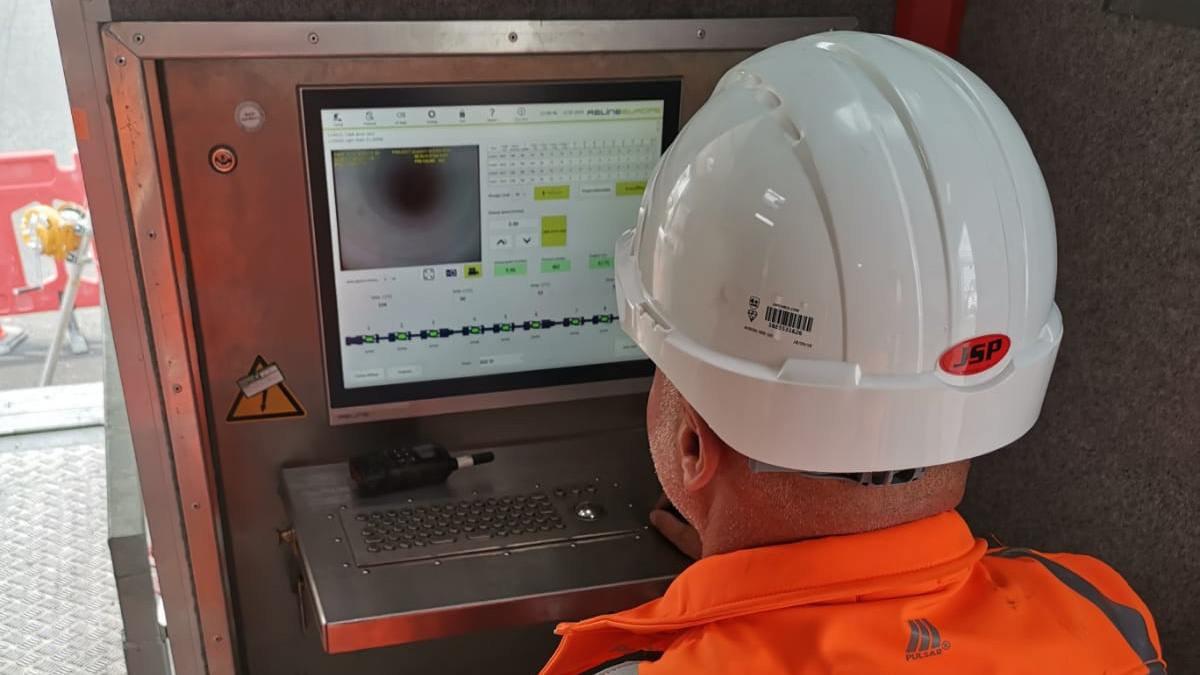
The UV train that is used to cure the liner is controlled remotely from the surface – Courtesy of TPMD
CIPP liner design: Phase one was the first time that a CIPP liner was used as a standalone liner. The structural glass reinforced liners were designed to have circular or oval cross-sections. The adit dimensions vary, so having a range of liner diameters from 150mm to 1,500mm was valuable for flexibility. The liner design minimised the environmental impact by eliminating the need for a grout surround. The remote installation method contributed to the health and safety record of the project discussed later in the article.
The CIPP liners were designed to be self-supporting and resist over-inflation. Rigorous impact-load testing was undertaken to ensure the liners could withstand any future falling debris from the adit crown.
The original innovative concept for this phase was where possible to use a ‘close-fit’ liner that would ‘hug’ the adit wall to maximise adit storage. However, it became apparent that the adit surface was too rough to facilitate the technique using the current suite of liners without additional enabling works. It is envisaged that the design development undertaken including finite-element analysis creates a useful platform for using this approach in the AMP7 scheme, given the rapid technological advancement of liner design.
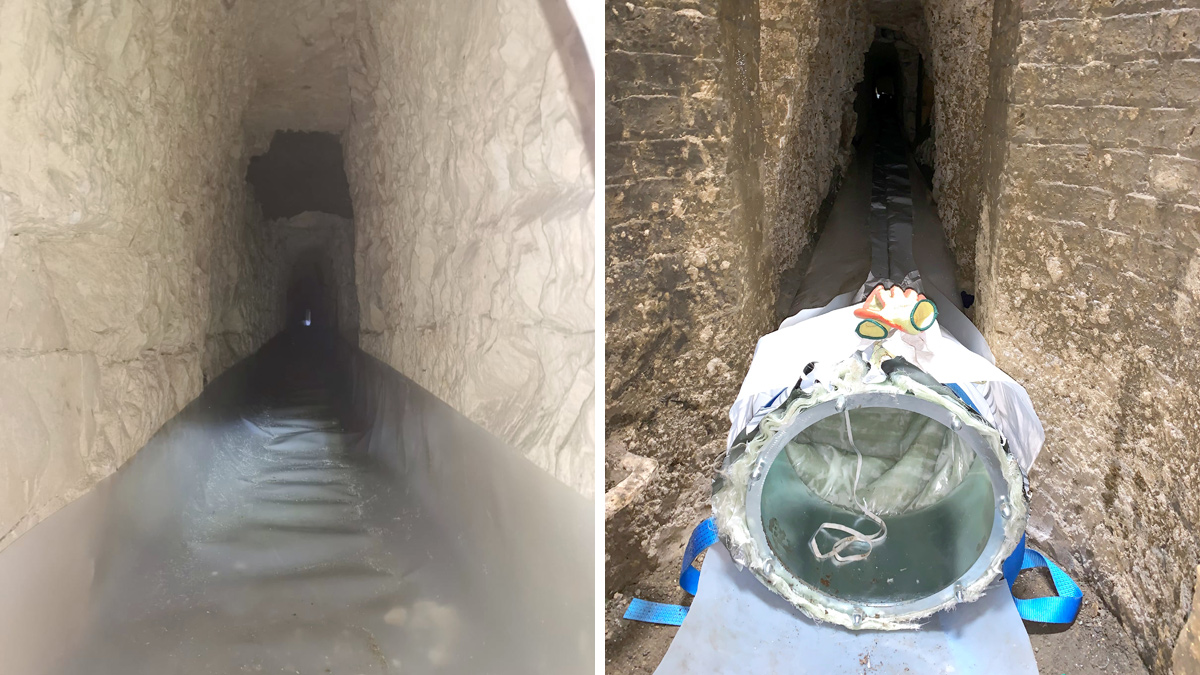
(left) London Road lining preparation and (right) the tunnels are lined using a CIPP liner, these liners are used to minimise water exfiltration, protecting the aquifer below – Courtesy of TPMD
Delivery
Working in partnership, Southern Water engaged with confined spaces and trenchless technology experts, TPMD – a joint venture made up of Terra Solutions, Pfieffer and Matt Durbin Associates. As part of the innovative use of CIPP liners, to provide a solution to the challenge, Southern Water engaged Water Research Centre (WRC) to support the technical design and installation of large diameter CIPP liners in the chalk tunnels.
The chosen solution overcomes a wide range of technical, social and environmental challenges and represents an investment of £34m across Ramsgate and Broadstairs. The solution consists of:
- 7km of CIPP tunnel lining.
- 2.1km of upsized pipework.
- 1.9km of new pipework.
- 185 (No.) existing manholes demolished and rebuilt.
- 80 (No.) new manholes (up to 24m deep).
- 85 (No.) rehabilitated manholes.
- 2 (No.) large storage tanks.
Construction phase
Through rigorous and complex man-entry surveys, it was found that circa 1.6km of tunnels were in a very poor condition, some that required urgent intervention. This included, in some locations, collapses that created voids beneath the road surface with the potential for sink holes to form. These needed to be repaired immediately, using no-dig techniques, to fill the voids and stabilise the tunnel.
The information gathered during the surveys was used to update the hydraulic model, which in turn updated the scope of work. As a result of the sensitivity of the model and the changing scope, it required close proactive planning, coordination and collaboration with Kent County Council (KCC) Highways and the EA. To add to the complexity of the planning, any changes to the scope impacted by site conditions, required the process to be continuously reassessed.
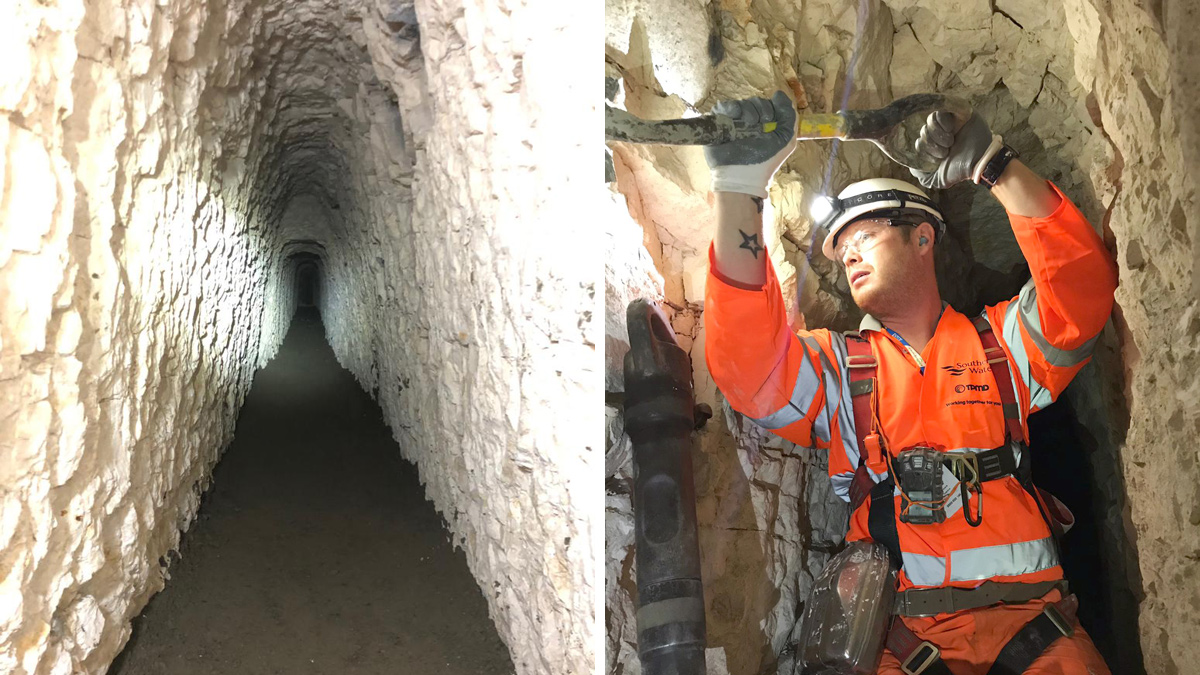
(left) Once the tunnels have been cleared and the sewer pipes repaired, a concrete floor is laid to protect the pipes and house the UV cured-in-place pipe (CIPP) liner and (right) miners work within the tunnels to make the necessary repairs and prepare them for lining – Courtesy of TPMD
A typical sequence includes refurbishing and replacing existing manholes to allow construction activities to be undertaken with safe access and egress into the sewer network. This is followed by sewer rehabilitation, that ensures the pipework lying on the tunnel floor is structurally sound, then the removal of silt and debris allows for the relocation and realignment of existing lateral connections before a protective concrete base is laid to facilitate the CIPP lining installation.
The above sequence is being repeated as part of a coordinated programme in more than 100 locations.
Health & safety
With an 80-strong workforce, ensuring safe working methods is paramount – many of the underground tunnels are in excess of 10m below the surface and have multiple vertical and horizontal crossings. The high-risk confined space environment required project-specific health and safety management systems, maintaining very high industry standards.
This is reflected by an exemplary project safety record to date of more than 141,000 man hours worked between August 2018 and May 2019, without any lost-time incidents.
Environment
Early involvement and on-going engagement with the EA provides a collaborative approach, ensuring the environmental drivers for the scheme are delivered. Innovation was key, through the use of trenchless and man-entry techniques which require a small site area, reducing disruption and carbon footprint and limiting the environmental impact.
Great care was taken to develop techniques that avoid the use of any materials that may have had a detrimental impact on the aquifer or wider environment. Through collaboration with the EA it was agreed that the use of a UV cured CIPP liner, as opposed to a more traditionally cured liner, would remove the requirement of using chemicals and resins in the curing process.
To reaffirm the collaborative approach, the EA were actively engaged with the site teams to promote good working practice when working close to an aquifer, including spill prevention and control, and waste management.
Community
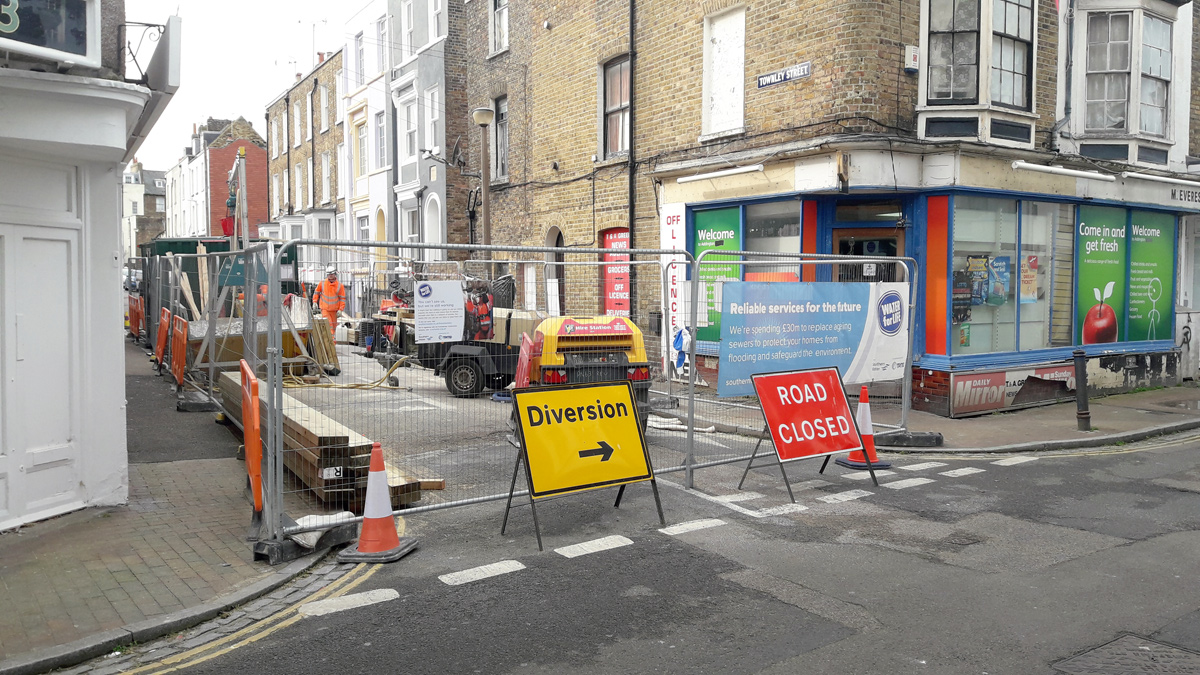
Typical site set-up repeated in as many as 19 locations at any one time – Courtesy of TPMD
With work being undertaken at 15 sites at any one time, and the presence of other utility companies making improvements in the area, the project team has forged a close working relationship with KCC Highways for traffic management, needed to allow progress of the work with the least possible impact on local road users.
Proactive planning was critical and a complex programme to coordinate traffic movements was agreed. Flexible working was adopted to minimise disruption to the local communities, with various elements being undertaken at night, weekends and during school holidays – key for the 18 schools in the vicinity.
A dedicated liaison team maintains close contact with the community and stakeholders to give an understanding of the need for the work and discuss progress and answer any queries. Between August 2018 and May 2019, more than 22,000 letters had been hand-delivered to customers to keep them informed.
Summary
Collaboration with key stakeholders, partners and local communities from conception has enabled the project team to deliver a complex and innovative solution, currently being delivered on time and to budget, while maintaining impeccable health, safety, quality and environmental standards.


